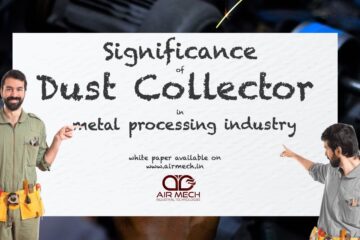Introduction: The Hidden Threat in Food Processing
At first glance, a food processing facility may appear spotless—gleaming floors, sanitized surfaces, and workers in clean uniforms. However, invisible to the naked eye, airborne dust particles circulate through the air, settling on equipment, ingredients, and final products. In one case, a bakery ignored minor dust buildup, only to suffer a major product recall when contaminants were detected in their packaged goods. The financial loss? Over $1.5 million in wasted inventory and regulatory fines.
Dust accumulation isn’t just a cleaning issue—it’s a serious operational risk that can lead to contamination, regulatory penalties, and mechanical failures. This article explores the top five dust control solutions for food processing environments to ensure safety, compliance, and efficiency.
1. Centralized Dust Collection Systems
Issue: Widespread Dust Contamination
❌ Problem: Flour, sugar, spice, and grain dust can become airborne, contaminating products and work areas.
🔍 Symptoms: Visible dust layers, failed microbial tests, cross-contamination issues.
✅ Solution: A centralized dust collection system efficiently captures airborne dust at multiple points in the facility.
Best Practice:
- Install baghouse or cartridge filtration systems to capture fine particles.
- Position extraction hoods at high-dust zones such as mixing and packaging areas.
2. Source Capture with Localized Extraction Units
Issue: Dust Emission at Critical Production Points
❌ Problem: Grinding, milling, and mixing release large amounts of dust into the air.
🔍 Symptoms: Clogged filters, increased cleaning efforts, respiratory issues among workers.
✅ Solution: Localized extraction units capture dust directly at the source before it spreads.
Best Practice:
- Use high-efficiency cyclone separators for coarse particles.
- Deploy portable extraction arms at high-dust workstations.
3. High-Efficiency HEPA Filtration Systems
Issue: Fine Dust and Airborne Contaminants
❌ Problem: Ultrafine dust particles remain airborne, affecting air quality and worker health.
🔍 Symptoms: Increased allergy and respiratory issues, difficulty meeting air quality standards.
✅ Solution: HEPA filtration systems remove 99.97% of airborne dust particles down to 0.3 microns.
Best Practice:
- Install air purifiers with HEPA filters in packaging and quality control areas.
- Ensure regular filter maintenance to maintain peak efficiency.
4. Proper Housekeeping and Preventative Maintenance
Issue: Accumulation of Settled Dust
❌ Problem: Settled dust can become airborne again, leading to contamination and equipment damage.
🔍 Symptoms: Frequent re-cleaning, buildup in vents and ducts, higher HVAC maintenance costs.
✅ Solution: A rigorous cleaning schedule and preventative maintenance prevent dust from accumulating.
Best Practice:
- Use industrial vacuum systems instead of compressed air, which redistributes dust.
- Implement scheduled filter replacements and duct cleaning.
5. Explosion-Proof Dust Management for Combustible Dust
Issue: Risk of Dust Explosions
❌ Problem: Fine dust particles from flour, starch, and sugar are highly combustible, creating fire hazards.
🔍 Symptoms: Frequent dust layer formation, increased static buildup, overheating equipment.
✅ Solution: Explosion-proof dust collection systems with spark arrestors and proper ventilation.
Best Practice:
- Install grounded ductwork and static elimination devices.
- Use intrinsically safe vacuum systems for hazardous dust removal.
Why Invest in a Reliable Dust Control Solution?
At Air Mech Industrial Technologies, we provide tailored dust collection solutions to help food processing facilities maintain a cleaner, safer, and more efficient working environment. Our solutions ensure:
✔ Compliance with food safety regulations
✔ Reduced contamination risks
✔ Extended equipment lifespan
✔ Improved worker health and safety
Final Thoughts
Effective dust control in food processing isn’t just about cleanliness—it’s about product safety, regulatory compliance, and operational efficiency. Implementing the right dust collection systems can reduce contamination risks, protect workers, and optimize productivity.
Is your facility equipped with the right dust control solutions to ensure a contamination-free production environment?
In many manufacturing facilities across India, a persistent layer of fine dust settles on machinery and workspaces despite regular cleaning. This recurring issue leads to frequent equipment malfunctions and an increase in worker respiratory problems. Industrial dust is a major challenge, impacting both operational efficiency and employee health in various sectors.
Identifying Common Issues
Industrial dust in manufacturing units can lead to:
- Equipment Wear and Tear: Accumulated dust accelerates machinery degradation, increasing maintenance costs.
- Health Hazards: Workers exposed to high levels of dust are at risk of respiratory diseases. In 2019, air pollution contributed to 1.67 million deaths in India, accounting for 17.8% of the country’s total deaths (worldbank.org).
- Fire and Explosion Risks: Certain dust particles are combustible, posing serious fire hazards.
Causes of Each Problem
- Inadequate Ventilation: Poor airflow allows dust to accumulate.
- Lack of Dust Control Systems: Absence of proper dust collection mechanisms leads to unchecked dispersion.
- Substandard Housekeeping: Irregular cleaning schedules contribute to dust buildup.
Symptoms and Signs
- Visible dust layers on surfaces.
- Increased frequency of equipment malfunctions.
- Workers reporting respiratory discomfort or illnesses.
Step-by-Step Solutions
- Assess Dust Levels: Conduct air quality assessments to determine dust concentration.
- Install Dust Collectors: Implement dust collection systems to capture airborne particles.
- Enhance Ventilation: Upgrade ventilation systems to improve air circulation.
- Regular Maintenance: Schedule routine checks for dust accumulation and system efficiency.
- Employee Training: Educate workers on best practices for minimizing dust generation.
Maintenance Best Practices
- Routine Inspections: Regularly check dust collectors and ventilation systems.
- Filter Replacements: Change filters as per manufacturer recommendations.
- System Calibration: Ensure equipment is calibrated for optimal performance.
Safety Considerations
- Personal Protective Equipment (PPE): Provide appropriate PPE to workers.
- Emergency Protocols: Establish procedures for dust-related incidents.
- Compliance with Regulations: Adhere to the Occupational Safety, Health, and Working Conditions Code, 2020, which emphasizes worker health and safety (dgfasli.gov.in).
Expert Tips and Advice
- Source Control: Identify and mitigate primary dust generation points.
- Continuous Monitoring: Utilize air quality monitors to track dust levels in real-time.
- Engage Professionals: Consult with industrial hygienists for tailored solutions.
Recommended Tools and Resources
- High-Efficiency Dust Collectors: Invest in advanced dust collection systems.
- Air Quality Monitors: Deploy devices to monitor particulate levels.
- Training Programs: Implement educational initiatives for staff on dust management.
Follow-up and Monitoring
- Regular Audits: Conduct periodic reviews of dust control measures.
- Health Surveillance: Monitor worker health for dust-related conditions.
- Feedback Mechanisms: Encourage employees to report dust issues promptly.
Air Mech Industrial Technologies offers state-of-the-art dust collection solutions designed to meet the unique challenges of India’s manufacturing sector. Our systems enhance air quality, protect equipment, and promote a safer workplace.
Conclusion
Addressing industrial dust is crucial for the health and efficiency of manufacturing operations in India. By implementing effective dust control measures, companies can safeguard their workforce and optimize productivity. Is your facility equipped to handle the challenges of industrial dust?





